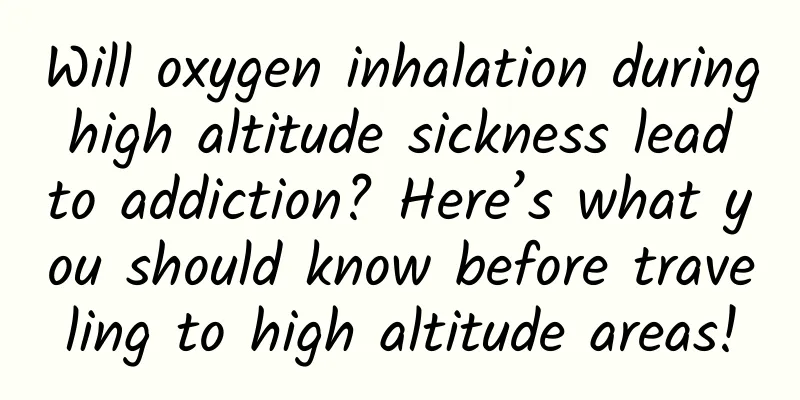Will oxygen inhalation during high altitude sickness lead to addiction? Here’s what you should know before traveling to high altitude areas!

|
gossip "When you have altitude sickness, you will become addicted to oxygen!" When traveling to the plateau, if you experience altitude sickness, do not use oxygen. Oxygen use will cause dependence, and it will be difficult to get rid of it in your lifetime! Rumor Analysis This statement is incorrect. Oxygen inhalation is a common method to relieve altitude sickness. There is no evidence that oxygen inhalation will cause dependence. If oxygen inhalation is not given in time when it is needed, it may lead to more serious consequences. During the National Day holiday, many people will choose to travel to plateaus and mountainous areas. The scenery in these places is indeed beautiful, but when traveling in these places, you should pay attention to "doing what you can", because many people will have altitude sickness when they go to plateau areas, which may endanger their lives if they are not treated in time. Many people choose to breathe oxygen to relieve altitude sickness, but there are many rumors online that "oxygen breathing can be addictive." So, is this true? What should you do when altitude sickness occurs? What should you pay attention to when going to plateau areas? Why does altitude sickness occur? Most people in our country live at relatively low altitudes. In these places, the air pressure is higher than in plateau areas, and the oxygen partial pressure in the air is also relatively high, so it can enter the blood more easily through the lungs and be transported to tissues and organs throughout the body. However, the air in high altitude areas is thinner, the air pressure is lower, and the oxygen partial pressure is also lower. Compared with plain areas, oxygen is not so easy to enter the blood. People who have lived in low altitude areas for a long time may not be able to adapt to the low oxygen environment when they enter the plateau. Especially when people quickly move from plains to plateaus, such as flying directly from plains to the Qinghai-Tibet Plateau, the body does not have enough time to adapt to this change, and a series of reactions will occur. Common symptoms include headache, dizziness, nausea, fatigue, shortness of breath, rapid heartbeat, etc. This is what people often call altitude sickness, also known as "acute mountain sickness." Acute mountain sickness itself is not fatal. Its danger lies in that it may cause high-altitude pulmonary edema and high-altitude cerebral edema, which are more dangerous and may be life-threatening in severe cases. How high a mountain to climb Will there be altitude sickness? If you go to a mountain with a relatively low altitude, you don't need to worry about altitude sickness. According to the Merck Manual, most people can climb to an altitude of 1,500 to 2,000 meters in a day without experiencing altitude sickness. 20% of people will begin to experience altitude sickness if they climb to an altitude of 2,500 meters in one day, and 40% of people will experience altitude sickness if they climb to an altitude of 3,000 meters in one day. According to this theory, most of the mountains in the eastern part of our country are at relatively low altitudes and will not cause altitude sickness. However, if you go to Tibet, Qinghai, Yunnan, and some places in Sichuan, you may experience altitude sickness. Especially if you fly directly to Lhasa, which is 3,650 meters above sea level, the proportion of people who experience altitude sickness should not be too low. Will oxygen inhalation cause dependence when altitude sickness occurs? There is no evidence that oxygen inhalation can lead to dependence, and people will not need oxygen for life after returning to the plains. On the contrary, if oxygen is not taken in time, it may cause more serious consequences. Because the cause of altitude sickness is related to the decrease in oxygen content in the blood, oxygen inhalation can quickly increase the oxygen content in the blood, protect the brain, relieve symptoms of difficulty breathing, reduce the respiratory rate, and prevent further deterioration of altitude sickness. In addition, for high-altitude pulmonary edema and high-altitude cerebral edema, doctors will also recommend returning to low altitude areas as soon as possible. Before that, in addition to drug treatment, patients will also be given hyperbaric oxygen chamber oxygen therapy in a timely manner. Therefore, when traveling to plateau areas, you should breathe oxygen when it is necessary to do so so that you can adapt to the plateau environment as quickly as possible. What should I do if I experience altitude sickness? If the symptoms of altitude sickness are mild, such as slight headache, dizziness, and drowsiness, there is no need to worry too much. You can rest more, don’t arrange a too tight schedule for the time being, and don’t continue to go to areas with higher altitudes. You should rest for a day or two first, and then continue to travel after the symptoms are alleviated and your body has adapted to the current altitude. However, if the symptoms continue to worsen after resting, or if you have severe headaches, nausea, or breathing difficulties at the beginning, you should seek medical help immediately. Do not travel because you "can't bear to waste time", otherwise you may develop more dangerous diseases such as high-altitude pulmonary edema and high-altitude cerebral edema. After all, life safety is the most important thing when traveling. How to avoid altitude sickness? Of course, for many people living in the plains, it is not easy to go to the plateau. Wouldn't it be a pity if the vacation you have planned with great difficulty was ruined because of altitude sickness? Is there any way to relieve altitude sickness? Of course there are. For ordinary people, the easiest thing to do is to arrange the itinerary reasonably. For example, the Merck Manual of Diagnosis and Treatment states that the best way to prevent altitude sickness is to slow down your climbing speed and not increase your altitude quickly. If you have enough time, it may be better to go to the Qinghai-Tibet Plateau by train or car than by plane. If you don't have enough time, don't rush to arrange a tight schedule immediately after flying to Lhasa or other cities, let alone go to higher altitude attractions such as Mount Everest Base Camp. It is recommended that you spend a day or two in the city you are in after arriving at the plateau, and do not overexert yourself to allow your body to adapt to the plateau environment. If you have a mild altitude sickness, do not drink alcohol and try not to take sedatives. For hiking enthusiasts, you should be more careful when hiking at high altitudes. If you are hiking at an altitude of more than 3,000 meters, it is recommended that you should not go to bed 500 meters higher than the previous day. Even if you have climbed to a higher altitude during the day, you should go back to a lower altitude when you go to bed at night. If you know for sure that you will have severe altitude sickness, then try not to travel to plateau areas. After all, beautiful scenery is not only found in plateaus. In any case, if you feel unwell while traveling in high altitude areas, do not try to hold on, and seek medical help in time. After all, altitude sickness should not be taken lightly. Finally, I wish you all a happy holiday and safe journey! Looking in the mirror of rumors Some people will panic when they hear the word "dependence", and may even deny it completely with the mentality of "it is better to believe it than not to believe it". In fact, taking one more step forward and doing one more step of verification can avoid many such misunderstandings. In addition, many people who have lived in plains for a long time will experience altitude sickness when traveling to plateaus. It is recommended that you make strategies and preparations before departure to ensure safe travel. References [1] https://www.msdmanuals.cn/home/injuries-and-poisoning/altitude-illness/altitude-illness [2] Simancas‐Racines D, Arevalo‐Rodriguez I, Osorio D, et al. Interventions for treating acute high altitude illness[J]. Cochrane Database of Systematic Reviews, 2018 (6). [3] https://wwwnc.cdc.gov/travel/page/travel-to-high-altitudes [4] Savioli G, Ceresa IF, Gori G, et al. Pathophysiology and therapy of high-altitude sickness: practical approach in emergency and critical care[J]. Journal of Clinical Medicine, 2022, 11(14): 3937. Author: Xiaowei Popular Science Creator Reviewer: Tang Qin, Director of the Science Popularization Department of the Chinese Medical Association, National Health Science Popularization Expert |
Recommend
IEA: Developing a definition of hydrogen based on emissions intensity
The IEA has published the report “Towards a defin...
Should I open the windows? — A bizarre COVID-19 outbreak
After three years of fighting the epidemic, weari...
The 10 most common problems on Android
[[156039]] Here are the most common React native ...
Take the Sterculia lychnophora out of your cup quickly!
When you were in school, have you ever seen this ...
How to optimize conversion rate through channel conversion model?
Advertising guru John Wanamaker once said, "...
How to divert private domain traffic?
"Private domain" has almost become an u...
Square dance mini program development function, how much does it cost to make a square dance mini program?
Speaking of square dancing, I believe everyone is ...
Advanced! Beijing Winter Olympics will test nucleic acid in the air | Tutu Science Fiction
Q Can’t tell the difference between aerosols and ...
A pamphlet distributed at an international chemistry conference dispelled the fog of molecular theory
People today seem to be getting more and more acc...
Top 10 operational promotion cases in the first half of 2020
2020 will surely be a year that goes down in hist...
"Taming" proteins in a test tube: directed evolution of enzymes
The continuation of life requires energy, and the...
Common and typical user growth flywheel model
Today we will share the growth flywheel models co...
How to promote Juliang Qianchuan and what is the promotion effect of Juliang Qianchuan?
With the launch of the massive Qianchuan platform...
[Creative Cultivation Program] Getting angry can actually cause poisoning?! In the hot summer, you need to calm down and cool down naturally
Author: Chen Wen Reviewer: Department of Neurolog...
How did NetEase Cloud Music and Mobile QQ change their skins?
Android theme skinning can provide skin packages ...









